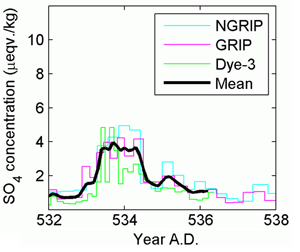Historic volcanic eruption unveiled in Greenland ice cores
A major volcanic eruption in A.D. 535 was the cause of a climatic downturn that wrecked worldwide havoc. This is the conclusion reached by an international team of researches including several glaciologists from the Centre for Ice and Climate. The conclusion is based on the discovery of volcanic sulphate deposits in both Greenland and Antarctic ice cores - as well as tree-ring evidence of a major climatic downturn starting in A.D. 536.
The discovery has been published in Geophysical Research Letters and is discussed in a feature in Nature News and on the RealClimate blog.
Quotes from the Nature News feature "They really were the Dark Ages":
"An enormous volcanic eruption in the sixth century seems to have triggered catastrophic global cooling, perhaps precipitating famine, cultural conflict and plague across the planet. [...]"
"Any normal interpretation of the data would point to a volcanic origin," says Keith Briffa, a palaeoclimatologist at the University of East Anglia in the UK and an author of the new study. [...]
The fact that a sulphate layer can be seen not only in the northern but also the southern polar region implies that the eruption probably happened close to the Equator, so that its dust was dispersed all over the Earth. But the north bore the brunt of the climate effects - there's no sign of cooling in geological records from New Zealand, for example.

Sulphate deposits dated to A.D. 534±2 in three Greenland ice cores (Dye-3, GRIP, NGRIP). The dark line represents the average concentration in the three ice cores.
Briffa explains that, although it's not hard to spot such sulphate contamination of ice in principle, the hard part is constraining the dates of the layers enough to link them to the tightly dated tree-ring evidence of cooling, and to distinguish them from sulphate that came from smaller but nearer eruptions. This careful detective work was carried out by Bo Vinther and his co-workers at the University of Copenhagen, Denmark."
Links:
RealClimate - Nature News - Paper in GRL
